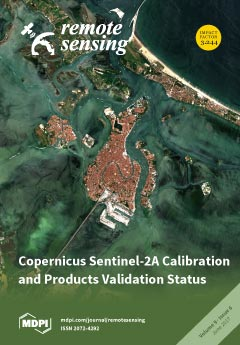1
Biospheric Sciences Laboratory, NASA/GSFC, Greenbelt, MD 20771, USA
2
IBG-2: Plant Sciences, Institute of Bio- and Geoscience, Forschungszentrum Jülich, 52428 Jülich, Germany
3
Science Systems & Applications Inc., Lanham, MD 20706, USA
4
Joint Center for Earth Systems Technology, UMBC, Baltimore, MD 21250, USA
5
Department Forestry & Environmental Resources, North Carolina State University, Raleigh, NC 27695, USA
6
Image Processing Laboratory (IPL), Parc Cientific, Universitat Valencia, 46010 Valencia, Spain
7
Remote Sensing Laboratories, University of Zurich, 8057 Zurich, Switzerland
8
Helmholtz Centre Potsdam, German Research Center for Geosciences (GFZ), 14473 Potsdam, Germany
9
Department of Environmental Sciences, University of Milano-Bicocca, 20126 Milano, Italy
10
Global Science & Technology, Inc., Greenbelt, MD 20770, USA
11
Universities Space Research Associates, Columbia, MD 21046, USA
12
Earth Observations, ESTEC, 2201 AZ Noordwijk, The Netherlands
13
Earth Observations, ESA-ESRIN, 00044 Frascati, Italy
†
Current Adress: Global Wheat Program, International Maize & Wheat Improvement Center (CIMMYT), 06600 México, D.F., Mexico.
‡
Retired.
add
Show full affiliation list
remove
Hide full affiliation list
Abstract
The first European Space Agency (ESA) and NASA collaboration in an airborne campaign to support ESA’s FLuorescence EXplorer (FLEX) mission was conducted in North Carolina, USA during September–October 2013 (FLEX-US 2013) at the Parker Tract Loblolly Pine (LP) Plantation (Plymouth, NC, USA). This
[...] Read more.
The first European Space Agency (ESA) and NASA collaboration in an airborne campaign to support ESA’s FLuorescence EXplorer (FLEX) mission was conducted in North Carolina, USA during September–October 2013 (FLEX-US 2013) at the Parker Tract Loblolly Pine (LP) Plantation (Plymouth, NC, USA). This campaign combined two unique airborne instrument packages to obtain simultaneous observations of solar-induced fluorescence (SIF), LiDAR-based canopy structural information, visible through shortwave infrared (VSWIR) reflectance spectra, and surface temperature, to advance vegetation studies of carbon cycle dynamics and ecosystem health. We obtained statistically significant results for fluorescence, canopy temperature, and tower fluxes from data collected at four times of day over two consecutive autumn days across an age class chronosequence. Both the red fluorescence (F685) and far-red fluorescence (F740) radiances had highest values at mid-day, but their fluorescence yields exhibited different diurnal responses across LP age classes. The diurnal trends for F685 varied with forest canopy temperature difference (canopy
minus air), having a stronger daily amplitude change for young vs. old canopies. The Photochemical Reflectance Index (PRI) was positively correlated with this temperature variable over the diurnal cycle. Tower measurements from mature loblolly stand showed the red/far-red fluorescence ratio was linearly related to canopy light use efficiency (LUE) over the diurnal cycle, but performed even better for the combined morning/afternoon (without midday) observations. This study demonstrates the importance of diurnal observations for interpretation of fluorescence dynamics, the need for red fluorescence to understand canopy physiological processes, and the benefits of combining fluorescence, reflectance, and structure information to clarify canopy function versus structure characteristics for a coniferous forest.
Full article





